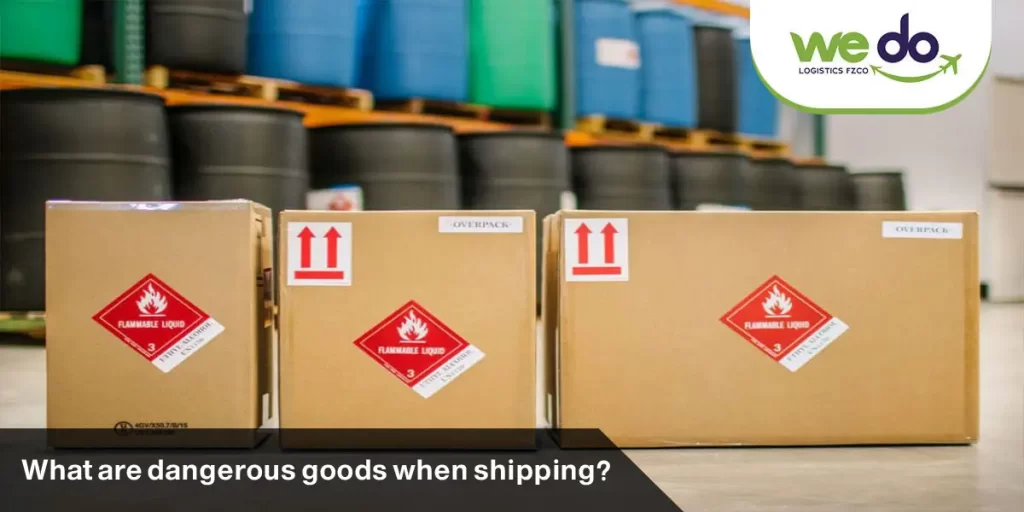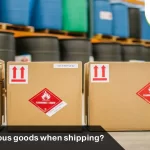Contents
- 1 What are hazardous goods in shipping?
- 2 Classification of hazardous goods:
- 3 Examples of other hazardous materials:
- 4 How to identify hazardous goods?
- 5 The importance of being certified to ship hazardous goods:
- 6 Special requirements for different transport methods:
- 7 Air transport:
- 8 Rail transport:
- 9 Truck transport:
- 10 Maritime transport:
- 11 Tips for shipping hazardous goods:
- 12 Adherence to regulations:
- 13 Complete knowledge of types of goods:
- 14 Following packaging and labeling regulations:
- 15 Customs clearance:
What are hazardous goods in shipping?
If shipping ordinary goods requires caution and care, what happens if we want to ship hazardous goods?
In this case, we must be more careful. When shipping ordinary goods, the main concern is to protect them from damage during the shipping and transport processes. However, when it comes to hazardous goods, our focus must not only be on protecting the goods but also on the fact that these goods pose a significant risk to the shipping crew and other cargo. Therefore, we must ensure that they are prepared with greater caution.
Classification of hazardous goods:
Hazardous goods are defined as those materials that may pose a significant threat to the safety of people, their health, and property during their shipping and transport. They include the following types:
- Explosive materials
- Gases of various types, including flammable, toxic, or even non-flammable and non-toxic gases
- Flammable liquids and solids
- Pesticides
- Oxidizing and chemical substances
- Toxic materials and those that may cause infections
- Radioactive materials
- Corrosive materials
- Other substances
Examples of other hazardous materials:
- Household cleaners
- Nail polish remover
- Oven cleaning products
- Cooking sprays
- Perfumes and deodorants
- Pest control products
- Spray paint
- And other materials
How to identify hazardous goods?
Before shipping any type of goods, it’s essential to first ensure what kind they are. This can be done through a specific code related to the materials to be shipped, obtained from the information in the Safety Data Sheet (SDS), previously known as MSDS. This document provides information about the goods being shipped to ensure they are transported correctly. For example, certain types of goods can be shipped by land, while others, due to their chemical composition, cannot be transported via land shipping.
There are also some non-hazardous materials that are still considered hazardous, such as:
- Lithium batteries.
- Dry ice.
- Aerosol sprays.
Additionally, some goods may become hazardous if exposed to vibrations, changes in air pressure, or temperature fluctuations. For instance, changes in pressure or air temperature during air transport can make those materials unstable, turning them into hazardous materials that could cause various issues.
The importance of being certified to ship hazardous goods:
If you are shipping hazardous goods, it requires specialized training for workers to complete the shipping processes of these goods effectively. The company must also have certification proving its capability to transport these materials.
The following steps should be taken when shipping hazardous goods:
- Labeling materials: Proper labels must be placed on the goods to guide those handling them about the nature of the materials and whether they are hazardous.
- Packaging: Hazardous goods must be packed and wrapped in a manner that minimizes their risks to protect anyone handling them.
- Documentation: Documents must be present to inform the shipper, handler, and receiver that the goods being transported are hazardous.
Special requirements for different transport methods:
Air transport:
Workers involved in the transport of goods must be certified and trained in handling hazardous goods optimally.
Rail transport:
There are strict regulations governing the preparation and manufacturing of trains, especially those used to transport hazardous materials, such as the designs of tank cars that must be completely safe during transport. Additionally, the transport team using trains must have high training levels, alongside security and rapid response to emergencies in case of any incidents. Due to these strong safety measures, 99.99% of all railway shipments arrive safely at their destination.
Truck transport:
Transporting hazardous goods on highways requires strong organization. Truck drivers must obtain approval to transport hazardous materials. There are also strict procedures during the loading and unloading operations for trucks carrying hazardous materials to ensure the highest level of safety.
Maritime transport:
In maritime transport, adherence to international regulations regarding hazardous materials is essential, along with compliance with local and international codes. The shipping company must handle storage, isolation, packaging, and classification of the goods itself.
Tips for shipping hazardous goods:
Adherence to regulations:
All local and international regulations and procedures regarding the transport of hazardous goods and their codes must be strictly followed to maintain the safety of these goods during shipping and transport.
Complete knowledge of types of goods:
The shipping company must be continuously aware of the nature of the materials it is transporting and know which ones are flammable, acidic, produce toxic fumes, or are harmful to the environment, or affected by pressure, among others. Accurately understanding the nature of the transported materials helps identify the best methods for transporting them and ensuring their highest safety standards.
Following packaging and labeling regulations:
When dealing with hazardous materials, they must be packaged appropriately according to each material, especially when packed with other goods. It’s essential to place them in locations that are easily accessible in case of an emergency.
Packages must be classified and coded to identify them as hazardous materials and be compatible with the goods they are shipped with. For instance, flammable materials should not be shipped alongside paper or plastic items. The shipper must adhere strictly to protocols for transporting these materials to ensure their safety as much as possible.
Customs clearance:
It is known that customs procedures take a considerable amount of time, but shipping hazardous materials requires very limited time. Therefore, customs procedures must be completed, and goods moved as quickly as possible.
To do this, the shipper must know everything about the goods being shipped to be ready for completing customs clearance without any delays, as any delay could increase the risks and damages that these materials may cause.
It’s also essential to refer to the international SDS document to understand the safe and legal way to prepare these goods. Moreover, relying on a special and secure warehouse for storing hazardous goods is crucial.
At the end of the packing process, specific labels must be placed on the shipping containers to indicate the types of hazards these goods may pose.
Given that regulations governing the transport of goods vary from country to country, it is crucial for the shipper to send an SDS document to the destination country for the hazardous goods shipment to avoid any future issues.





